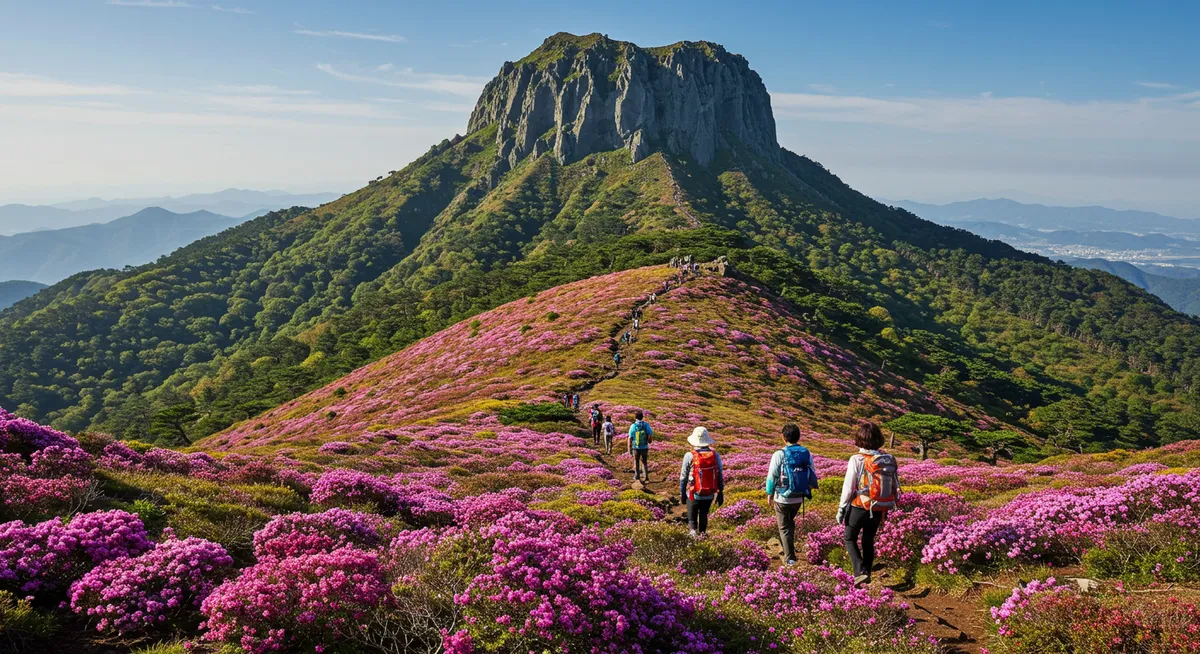
Hiking Hallasan: Best Time for Your Jeju-si Adventure
Table of Contents
The Ultimate Guide to Hiking Hallasan: When to Go
So, you’re dreaming of conquering Hallasan, South Korea’s highest peak, right here in Jeju-si? Awesome choice! As someone who’s personally tackled its challenging trails through sun, rain, and snow, I can tell you that timing is absolutely everything for an epic adventure. Hallasan offers a uniquely rewarding experience, from lush volcanic landscapes to breathtaking summit views, but hitting the trails during the right season can make all the difference between an unforgettable triumph and a less-than-ideal struggle. Let’s dive into when you should lace up those boots for the ultimate Hallasan trek.
Want to find the best travel deals for this destination? custom adventure planner with our adventure planning specialist!
Why Timing Your Hallasan Hike Matters
Embarking on the journey up Hallasan National Park is more than just a hike; it’s an immersive adventure that truly hinges on the season. Jeju Island’s weather can be notoriously fickle, and what might be a pleasant stroll in spring could be a slippery, challenging ascent in winter. Consider things like trail conditions, visibility, and, of course, the sheer number of fellow adventurers on the path. From my own experience, understanding these seasonal nuances is key to maximizing your enjoyment and safety. This majestic volcanic peak offers diverse beauty year-round, but your preparedness for Jeju-si adventures will be tested by the elements. A well-timed trip ensures you get the very best of Hallasan’s incredible landscapes.
Spring & Autumn: The Golden Seasons for Hallasan
Without a doubt, late Spring (April-May) and Autumn (late September-October) are generally considered the **best time for hiking Hallasan Jeju-si**. Why? The weather is typically mild, offering comfortable temperatures for strenuous activity. In spring, the slopes burst into vibrant azaleas, creating a stunning backdrop, while autumn transforms the mountain into a canvas of fiery red and gold foliage, a truly spectacular sight. Crowds are manageable, especially compared to summer, and visibility from the summit, including the iconic Baeknokdam crater lake, is usually excellent. If you’re looking for an alternative to Hallasan during peak times, consider exploring other best hiking trails in Jeju-si for beginners for a gentler experience.
Summer on Hallasan: Lush, Lively, and Popular
Summer (June-August) on Hallasan is a mixed bag. The mountain is incredibly lush and green, with long daylight hours perfect for a full-day ascent. However, be prepared for significant crowds, higher temperatures, and the potential for heavy rainfall, especially during monsoon season (late June to late July). My advice? Start your hike *super* early to beat both the heat and the crowds, and always pack rain gear. While less ideal for peak comfort, the vibrant flora and mist-shrouded peaks after a rain shower can offer a uniquely mystical experience. Despite the challenges, many still find the summer ascent of this iconic volcanic peak rewarding.
Winter Wonderland: Hallasan’s Snowy Peaks
Hiking Hallasan in winter (December-February) is a truly magical, yet demanding, experience. The entire mountain transforms into a breathtaking snow-covered wonderland, offering crisp air and stunning panoramic views. However, this season requires serious preparation. Trails can be icy and slippery, and temperatures plummet, especially at higher altitudes. Mandatory gear often includes crampons (ice cleats) and hiking poles. Park access can also be restricted during heavy snowfall, so check conditions daily. While it’s not the easiest time for hiking Hallasan, the pristine snowy landscape and the unique challenge make it incredibly rewarding for seasoned adventurers. I remember one winter hike where the silence was only broken by the crunch of snow underfoot – absolutely unforgettable.
Essential Gear & Permits for a Successful Ascent
No matter when you decide the best time for hiking Hallasan Jeju-si is for you, proper preparation is non-negotiable. Always wear sturdy hiking boots, layered clothing (even in summer, the summit can be chilly), and bring plenty of water and snacks. For winter, crampons, gaiters, and warm, waterproof outer layers are essential. Remember that permits are now required for the Seongpanak and Gwanneungsa trails (the main summit routes) and must be booked in advance via the Hallasan National Park reservation system. I cannot stress enough how vital a comprehensive essential packing list for your Jeju-si adventure trip is, along with checking weather forecasts and trail conditions just before you go.
Frequently Asked Questions
Recommendation: Don't miss out on amazing South Korea tours - book now!
Q: Do I need a permit to hike Hallasan?
A: Yes, permits are mandatory for the Seongpanak and Gwanneungsa trails (the summit routes) and must be reserved online in advance via the Hallasan National Park website. Spots are limited, especially during peak seasons, so book early!
Q: What are the main trails for hiking Hallasan?
A: The two main trails leading to the summit (Baeknokdam crater lake) are Seongpanak and Gwanneungsa. Other trails like Eorimok, Yeongsil, and Donnaeko offer scenic shorter hikes, but do not reach the summit.
Q: Is Hallasan suitable for beginner hikers?
A: While Hallasan offers various trails, the summit routes (Seongpanak and Gwanneungsa) are challenging and long, requiring good physical condition. Beginners might prefer the shorter, less strenuous trails like Eorimok or Yeongsil, which offer beautiful views without the full summit climb.
Choosing the best time for hiking Hallasan in Jeju-si truly depends on your priorities: vibrant nature, pleasant weather, or a snowy challenge. While spring and autumn offer the most comfortable conditions and stunning scenery, each season provides a unique perspective of this majestic peak. Regardless of when you go, proper preparation, permits, and a spirit of adventure are your best companions. Get ready to experience the unforgettable beauty of Hallasan!